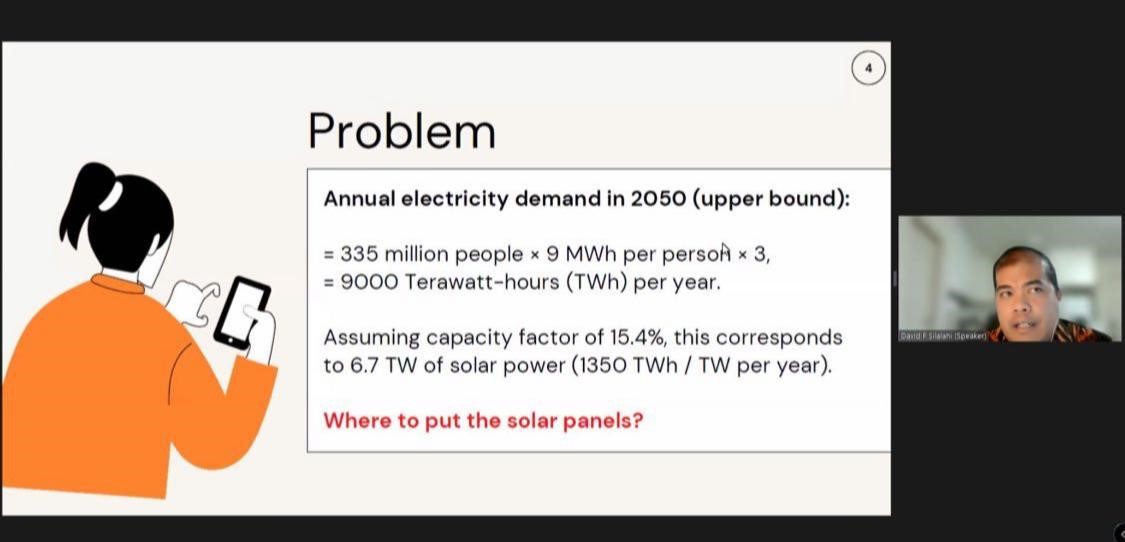Online, 29 Sept 2021
On 29 September 2021, ASEAN Climate Change and Energy Project (ACCEPT) held the seventh ASEAN Research Network Energy and Climate Change (ARNECC) Paper Talks with the topic of Indonesia’s Vast Solar Energy Potential which recently published in Energies. The lead author, Mr. David Firnando Silalahi, present the key findings and recommendation of the vast potential for solar photovoltaic (PV) in Indonesia. Two experts from leading renewable energy developers in Indonesia, Ms Prima Mangesthy Hati Maria and Mr Antonius Yongki Wijaya, shared their perspectives as the practitioners of private sector. The event was hosted by Ms. Monika Merdekawati, ACCEPT Research Analyst.

Figure 1 Presentation session by Mr David
The paper’s main objective is to systematically analyse Indonesia’s potential to generate enough renewable energy to be self-sufficient in energy. The paper explores the significant potential of solar energy for supplying future energy demands in Indonesia at a reasonable cost. Furthermore, this article estimates the substantial capacity of solar that could be hosted by defunct mines. Lastly, to identify the off-river pumped hydro as a low-impact, low-cost, and mature technology with far larger storage capacity. The study uses the three approaches for harnessing solar power: ground-mounted PV, floating PV, and rooftop PV.
By 2050, Indonesian power consumption would be 9000TWh per year, which is 30 times higher than current level. The highlight is that Indonesia has enough of room to install solar to meet the national demand with 100 % renewable energy. The solar placement is evaluated in 4 alternatives, roofs, inland reservoirs, mining wastelands, and agricultural land. The key recommendations include exploring solar PV on marine area with almost no strong winds or large waves, which potentially could generate >200,000 TWh per year and on off-river pumped hydro energy storage.
Additionally, rooftops and abandoned mining sites offer large-scale prospects with low environmental impact in the early stages of a transition to solar energy. When combined, they would allow for a six-fold increase in electricity generation. Solar PV in agricultural settings allows farmers to diversify their revenue. Partial shade by solar panels has no effect on productivity for many crops. Agricultural photovoltaics have the potential to meet a significant portion of Indonesia’s future energy requirements.
The panel discussion begins with feedback and question from Mr Antonius. He added the socio-economic perspective as the extension of paper. Since the land acquisition in Indonesia is often hinder the renewable energy projects in Indonesia thus, adding estimation on the solar PV levelized cost, would be helpful to demonstrate the real cost.
The next discussion comes from the second expert, Ms Prima, she asked Mr David’s opinion regarding the climate aspect of maritime floating solar PV. Since typhoon will significantly raise the project risk. Even though the utilised data was not directly from the site but from European Agency, but the data was already validated using the actual measurements. Also, the study has already look up to the last 50 years tropical storm in Asia Pacific and its surrounding. It can be concluded that Indonesia’s maritime area is safe from the high wind speed which it is only found in the northern part of Australia and southern part of China.
At the end of talks, the moderator summarised that the paper offers refreshing premise that 100% renewable energy is possible for Indonesia. However, many aspects such as social, economy, and environment, could be evaluated in the follow up study to improve the robustness of model and the applicability by private sector.
(JKH).